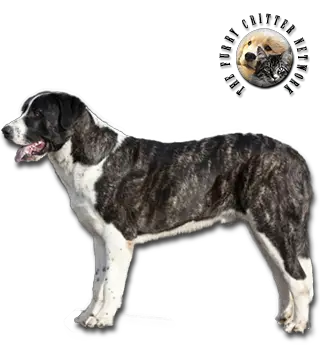Breed Standard
Head: Bearlike. Broad, domed skull. Slight stop. Domed nose bridge. Strong jaws. Oval nose. Thin lips.
Ears: Small, folded, triangular, drop.
Eyes: Small, oval. Dark color. Dark rims.
Body: Strong and long. Strong, short neck. Deep, broad chest. Broad loin.
Tail: Long, thick, carried down and curving slightly.
Hair: Short or medium length (preferred), smooth, coarse, and thick.
Coat: Black, wolf gray, fawn, or yellow, with or without white; or white with spots, stripes, or brindle.
Size: Dog: 66 to 74 cm (26-29 in).Bitch: 64 to 70 cm (25-27,5 in).
Weight: Dog: 40 to 50 kg (88-110,5 lb).Bitch: 35 to 45 kg (77-99 lb).
History
The Rafeiro do Alentejo are often claimed to be descended from huge dogs on the vast Tibetan highlands, thousands of years ago. These powerful mastiffs are commonly said to have migrated slowly westwards into Asia Minor. They are thought to have crossed the Balkans, following the Roman legions from the Black Sea to the shores of the Atlantic. Over so vast an area and through centuries of natural selection, they acquired characteristics of their own, which eventually differentiated them from region to region. In the Iberian Peninsula, tribes whose subsistence was based on the exploitation of cattle undoubtedly gave these dogs of great strength and size the unique task of protecting them against rival tribes and cattle rustlers. One could say that the Rafeiro, regarding its origin, looks, character and function is between the Anatolian Shepherd Dog and the Spanish Mastiff, (the perfect dog). In Portugal, with the geographic and climatic differences between North and South, the need soon arose of moving the cattle annually in search of better pastures. Consequently, for centuries, huge herds, accompanied by powerful mastiffs, were driven between the northern region of Douro and the Alentejo hinterland. As the population settled down, the dogs eventually remained in the southern prairies, where they adapted and began to be used to guard, not only the herds, but especially, in time, the big rural estates. However, it was not before 1953 that, thanks to a census carried out at the end of the 1940's by two distinguished sinologists (Antonio Cabral and Filipe Romeiras), the official standard of the Rafeiro of Alentejo was established. In the 60's and 70's this breed declined dramatically, both in quality and quantity, the most critical point being reached in the early 80's. It is, however, with great satisfaction that we can say that at the turn of the century this situation has been overcome, thanks to the zeal of a small but resolute group of breeders, who, with dedication and perseverance, are carrying out the rewarding task of ensuring the continuity of the Rafeiro do Alentejo. Today, even though the work must continue unabated, we can say that this precious heritage will be bestowed on future generations.
Behavior
The breed standard describes the breed as "sober" (meaning "marked by seriousness, gravity, or solemnity of conduct"), his movement as slow and rolling, and as having a calm expression. Individual dogs may vary in behavior and temperament, and puppies must be well socialized.
As with all very large dogs, they are not the dogs for beginners. Dogs of this size and type have the potential to be a danger to others if not well socialized at an early age, and are recommended only for the experienced dog handler who has the time to socialize and train the dog. This Mountain dog matures slowly, is very independent, and often does not respond to traditional force methods of dog obedience training. They are extremely territorial and will protect the sheep, households, and families they feel were placed under their protection. They are not aggressive but protective and are said to get along quite well with children.
This dog is not suited to city living. He needs exercise and room to run. Weekly brushing is sufficient. As with all very large dogs, they are not the dogs for beginners. Dogs of this size and type have the potential to be a danger to others if not well socialized at an early age, and are recommended only for the experienced dog handler who has the time to socialize and train the dog.
Function
Flock Guard, Guard and Defense Dog, Pet.
Health
Little data exists for health problems in this breed. However, when bred to be very oversize, they may be subject to hip dysplasia, and dogs with deep chests sometimes suffer from bloat.





